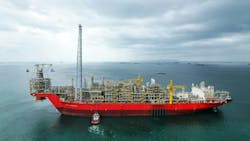Woodside Energy Group improved reserves for 2024, mainly due to strong performance from the Sangomar project, offshore Senegal.
Sangomar ramped up in less than 9 weeks and achieved more than 94% production reliability in fourth-quarter 2024, the company said (OGJ Online, June 10, 2024). Both water and gas injection systems have been fully commissioned, and the field produced 13.3 MMboe of crude in 2024.
Early performance from the S500 reservoirs showed good productivity with proved and proved plus probable reserves additions of 16.2 MMboe and 15.4 MMboe, respectively. The project includes four injector-producer well pairs in the S400 reservoirs. Water injection started in fourth quarter 2024, and migration of reserves associated with water injection is anticipated in 2025, pending additional well performance The project is forecast to continue producing on plateau into second-quarter 2025, about a year after first oil.
At end-2024, Woodside had remaining proved (1P) reserves of 1,975.7 MMboe, remaining proved plus probable (2P) reserves of 3,092.2 MMboe, and remaining 2C contingent resources of 5,869.7 MMboe. Excluding divestments and production, Woodside’s proved reserves increased by 54.9 MMboe and proved plus probable reserves increased by 46.2 MMboe.
The reserves additions were driven by Sangomar, successful financial investment decisions (FID) of projects in Australia and the US, and performance-based revisions across the portfolio, notably in the North West Shelf and Bass Strait. The divestment of 25.1% of Woodside’s equity interest in Scarborough field led to reductions in proved reserves of -323.0 MMboe, and proved plus probable reserves of -504.7 MMboe (OGJ Online, Feb. 23, 2024).

Alex Procyk | Upstream Editor
Alex Procyk is Upstream Editor at Oil & Gas Journal. He has also served as a principal technical professional at Halliburton and as a completion engineer at ConocoPhillips. He holds a BS in chemistry (1987) from Kent State University and a PhD in chemistry (1992) from Carnegie Mellon University. He is a member of the Society of Petroleum Engineers (SPE).

